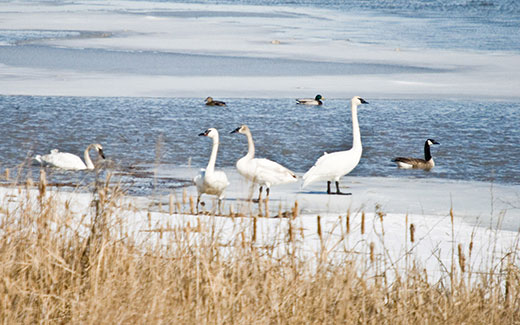 Spring cleaning Who would have thought that we would be seeing February days with sustained 60+ degree temperatures! While spring seems to want to make an early start, I have a feeling that we will still see more of old-man winter before spring puts him to sleep for the season. The warm days give us a glimpse of what we can enjoy in March, so here are some tidbits of things to keep in mind.
Spring cleaning Who would have thought that we would be seeing February days with sustained 60+ degree temperatures! While spring seems to want to make an early start, I have a feeling that we will still see more of old-man winter before spring puts him to sleep for the season. The warm days give us a glimpse of what we can enjoy in March, so here are some tidbits of things to keep in mind.
The sap is running The Peoria Park District’s Camp Wokanda has tapped about 40 sugar maples this year, and we have already harvested enough sap for about 5 gallons of Maple Syrup before February is half over. It’s a fascinating enterprise, and Camp Wokanda will be holding a workshop and pancake breakfast 9 a.m. to noon Saturday, April 1. Participants will see how maple sap is harvested and the process of how this sap is turned into maple syrup. To register, call Camp Wokanda at 309-579-2157.

Trumpeter Swans at Emiquon Preserve, Fulton County.
Stroll Singing Woods The Peoria Park District’s Tawny Oaks Field Station will be opening for the season from April 1 through Oct. 28. The visitor center hours are 10 a.m. to 4 p.m. Wednesdays through Saturdays. Trails are open daily from dawn to dusk. This facility provides access to Singing Woods, a 700-acre dedicated Illinois State Nature Preserve. Over the winter, volunteers have been working hard on the trails to provide access to this wonderful woodland. New trail sections will be ready for your spring stroll, so make sure to come out and see all of the spring woodland wildflowers in April and May. There are many programs through the season, so check out the Peoria Park District Website and “Like” Tawny Oaks on Facebook to find out more about the programs.
From the naturalist notebook Feb. 17 and Skunk Cabbage is poking its head out of our wetland seeps. With a name like “Skunk Cabbage,” you must be wondering about its odor. It’s true, this native plant does have a pungent smell. That smell is designed to attract early spring insect pollinators, mainly midges and flies that also like these moist soil areas. It tends to grow in areas, at the base of hillsides, where water “seeps” out of the ground. These areas tend to thaw early, and the plant also has the ability to warm the soil and get an early start. We have them growing at Singing Woods Nature Preserve in Peoria County, and they are also plentiful at Bennett’s Tera-Aqueous Gardens in East Peoria. If you go to Bennett’s in March, you will also see the yellow flowers of Marsh Marigold in bloom. A beautiful sight on a March day!
The warm weather has fooled many garden flowers. On the east side of Singing Woods, near the Skunk Cabbage, there is a place where a house used to stand. The house is long gone, but the woods tell a story if you understand the language. On this warm Feb. 17 day, Snowdrops bloom on the floor of the forest. These must have been planted by Lois Hite some 60 years ago when she lived here. A close look at the woods will reveal other garden plants; hostas, daffodils, and hyacinths still grow where once were gardens. Next to the snowdrops, there is a small metal tag. Punched into the tag in neat, orderly letters are the words “Queen Esther,” which note the particular variety of snowdrops that Lois must have planted. Lois and the house are long gone. We are stewards of the land for a fleeting moment of time, but what we do to the land lives long after our last breath. May we all strive to leave a legacy as beautiful as planting flowers that will outlive us.
Spring on the wing There have been numerous reports of huge flocks of Greater White-fronted Geese and Snow Geese early this year. Since ice is gone from the water at Chautauqua National Wildlife Refuge in Mason County and Emiquon Preserve in Fulton County, there have been reports of flocks of birds numbering over 100,000. When this many birds take off from the refuges, they actually show up on weather radar. You may see them feeding far afield from the refuges. It’s not unusual to see groups of thousands of birds in farm fields eating leftover corn and other seeds. This year, there have been regular flocks just south of Elmwood in Peoria County. Also, we have had reports of high numbers of Trumpeter Swans in our area as well. This is really encouraging since the eastern population of this species was wiped out early in the 20th century. Western birds were reintroduced to the Mississippi Flyway as part of the Endangered Species Recovery Program. It’s another example of just how important and successful the Endangered Species Act is to the recovery of our natural heritage.
While March can sometimes be a month that seems to drag on with dim, cold, resolve, this year seems different. At least it does today… Feb. 17, 2017, and it’s 67 degrees and sunny!
